Strategic Analysis of Uber: Technologies, Ethics and Market Forces
VerifiedAdded on 2023/06/11
|18
|4041
|465
Report
AI Summary
This report provides a comprehensive analysis of Uber's business, examining its use of emerging technologies, competitive positioning through Porter's Five Forces, and strategic evaluation using SWOT, BCG, Ansoff, and PESTLE frameworks. It delves into the role of Business Intelligence (BI) tools in Uber's operations, discusses the ethical considerations and potential moral hazards associated with its business model, and explores how IT can be aligned with business objectives. The report also draws lessons from the failure of Boo.com, emphasizing the importance of user experience and strategic planning when leveraging emerging technologies. The analysis covers Uber's strengths, weaknesses, opportunities, and threats, as well as political, economic, social, technological, legal, and environmental factors influencing its operations. Desklib offers a variety of solved assignments and past papers for students seeking further assistance.
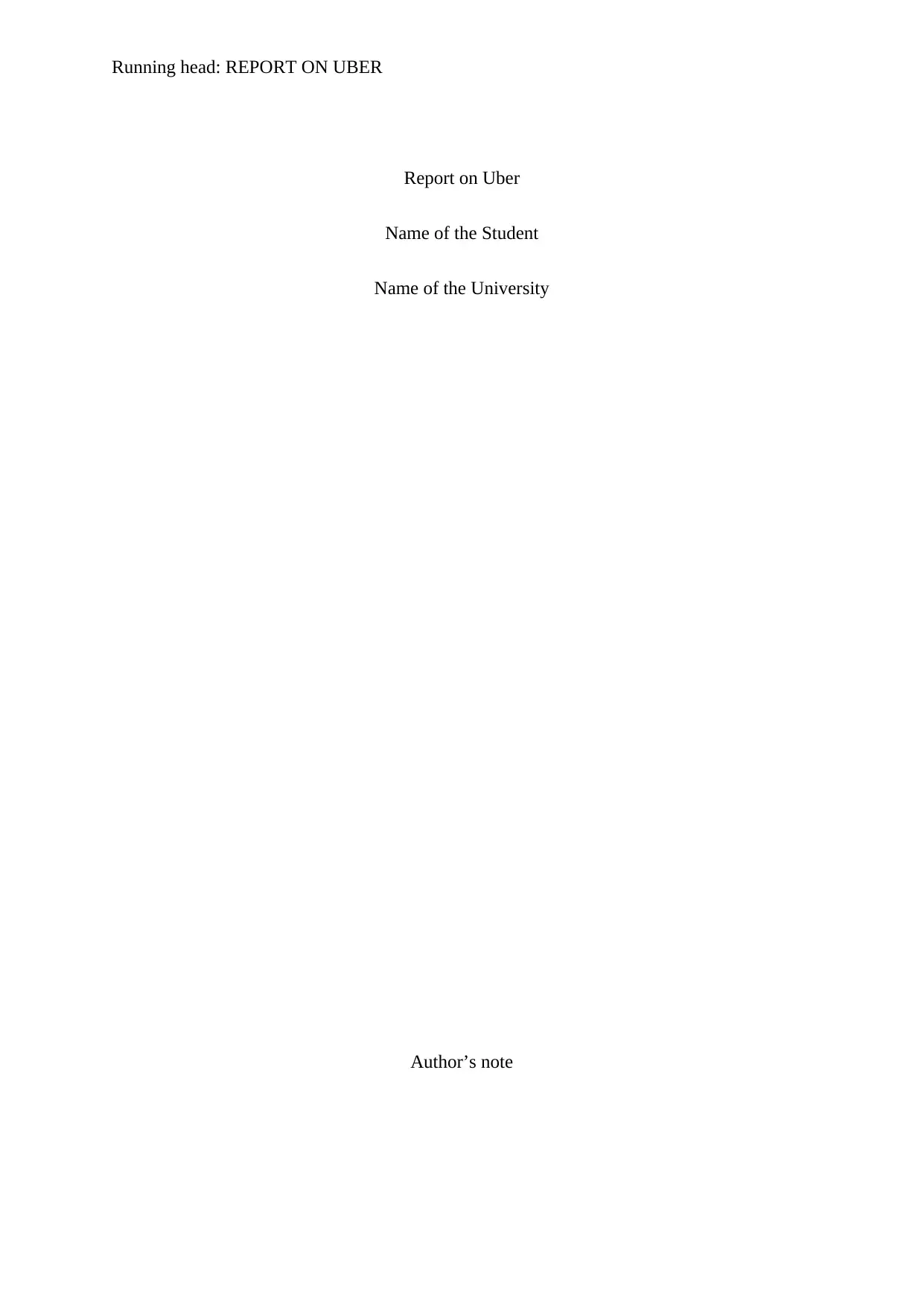
Running head: REPORT ON UBER
Report on Uber
Name of the Student
Name of the University
Author’s note
Report on Uber
Name of the Student
Name of the University
Author’s note
Paraphrase This Document
Need a fresh take? Get an instant paraphrase of this document with our AI Paraphraser
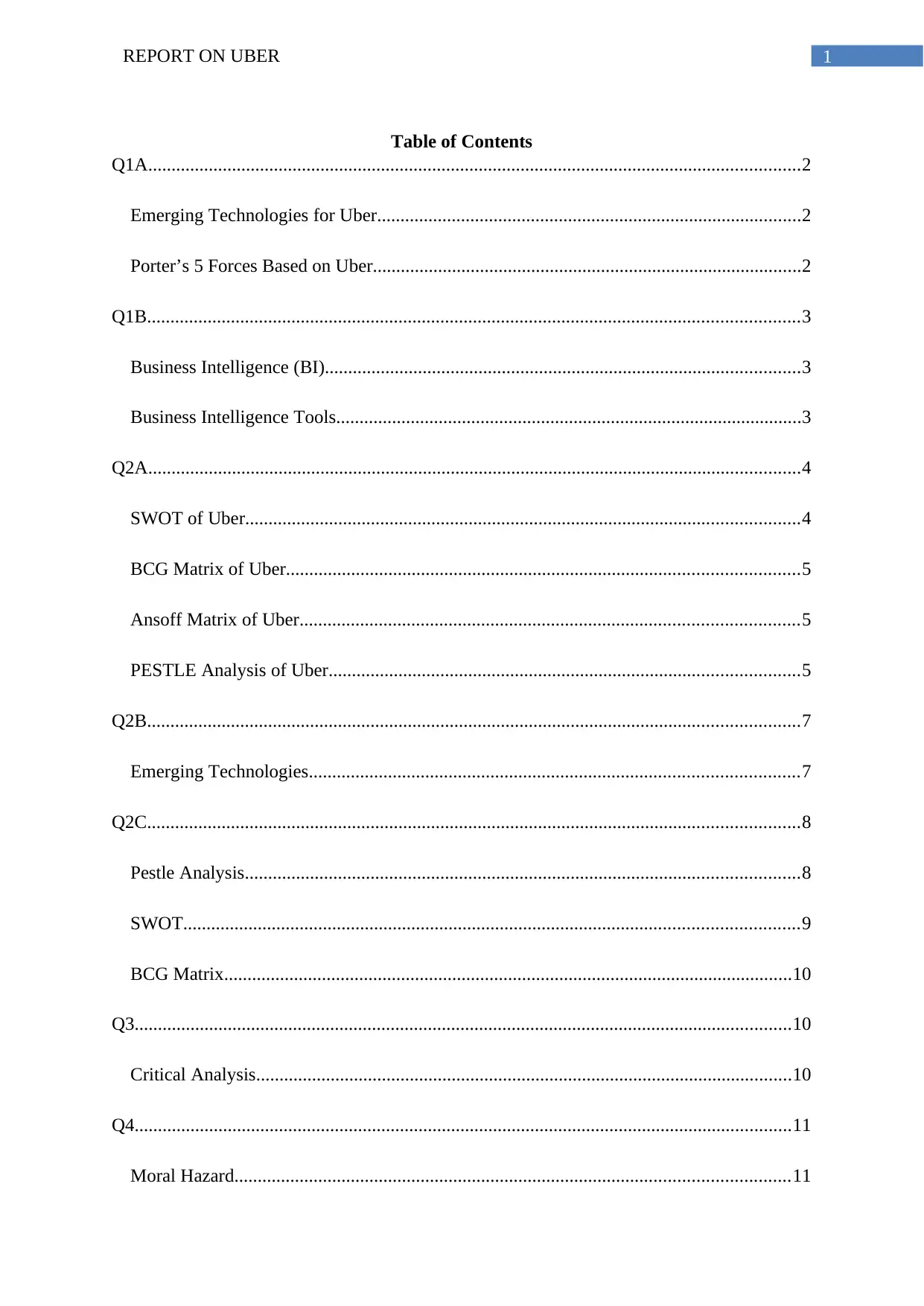
1REPORT ON UBER
Table of Contents
Q1A............................................................................................................................................2
Emerging Technologies for Uber...........................................................................................2
Porter’s 5 Forces Based on Uber............................................................................................2
Q1B............................................................................................................................................3
Business Intelligence (BI)......................................................................................................3
Business Intelligence Tools....................................................................................................3
Q2A............................................................................................................................................4
SWOT of Uber.......................................................................................................................4
BCG Matrix of Uber..............................................................................................................5
Ansoff Matrix of Uber...........................................................................................................5
PESTLE Analysis of Uber.....................................................................................................5
Q2B............................................................................................................................................7
Emerging Technologies.........................................................................................................7
Q2C............................................................................................................................................8
Pestle Analysis.......................................................................................................................8
SWOT....................................................................................................................................9
BCG Matrix..........................................................................................................................10
Q3.............................................................................................................................................10
Critical Analysis...................................................................................................................10
Q4.............................................................................................................................................11
Moral Hazard.......................................................................................................................11
Table of Contents
Q1A............................................................................................................................................2
Emerging Technologies for Uber...........................................................................................2
Porter’s 5 Forces Based on Uber............................................................................................2
Q1B............................................................................................................................................3
Business Intelligence (BI)......................................................................................................3
Business Intelligence Tools....................................................................................................3
Q2A............................................................................................................................................4
SWOT of Uber.......................................................................................................................4
BCG Matrix of Uber..............................................................................................................5
Ansoff Matrix of Uber...........................................................................................................5
PESTLE Analysis of Uber.....................................................................................................5
Q2B............................................................................................................................................7
Emerging Technologies.........................................................................................................7
Q2C............................................................................................................................................8
Pestle Analysis.......................................................................................................................8
SWOT....................................................................................................................................9
BCG Matrix..........................................................................................................................10
Q3.............................................................................................................................................10
Critical Analysis...................................................................................................................10
Q4.............................................................................................................................................11
Moral Hazard.......................................................................................................................11
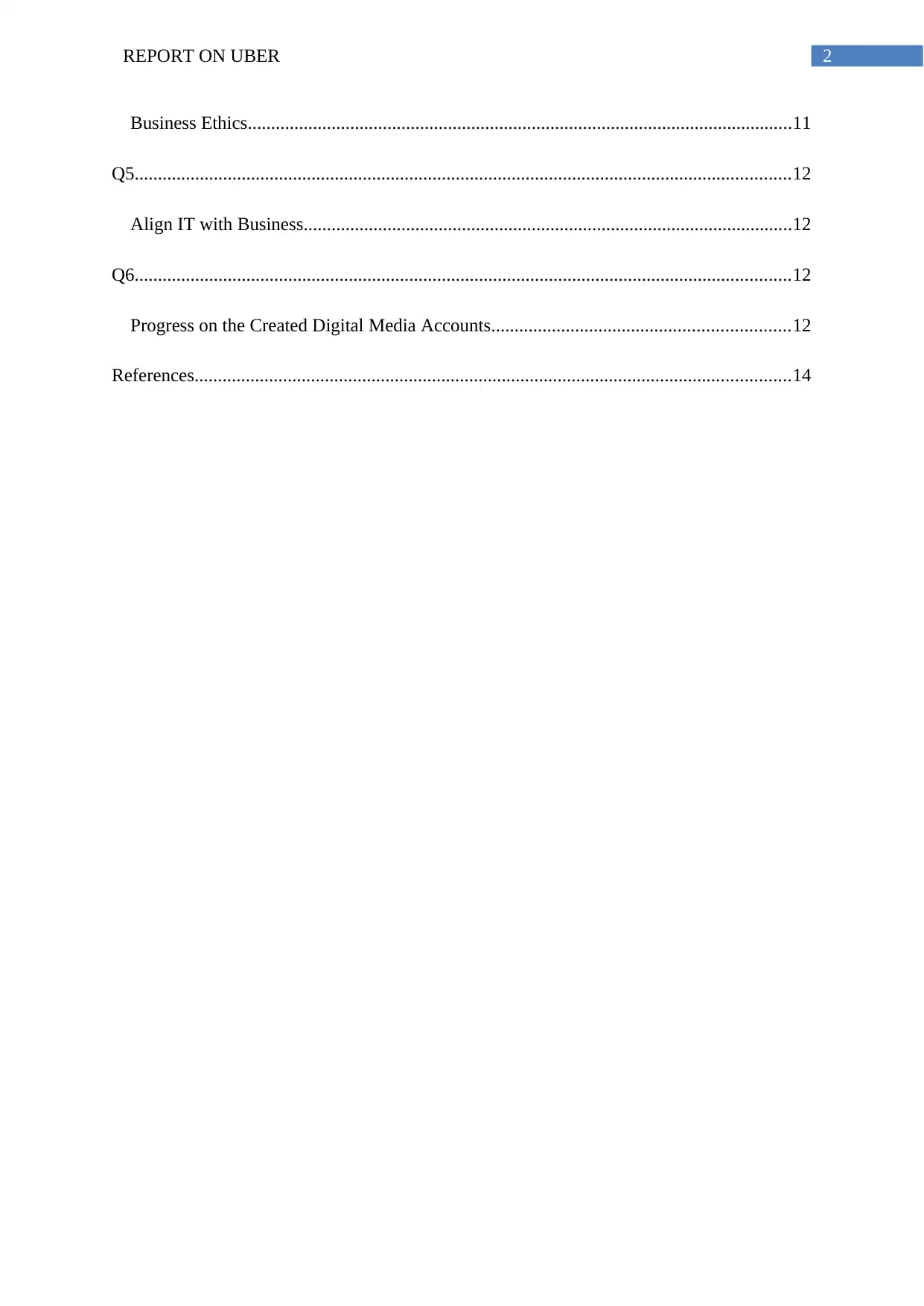
2REPORT ON UBER
Business Ethics.....................................................................................................................11
Q5.............................................................................................................................................12
Align IT with Business.........................................................................................................12
Q6.............................................................................................................................................12
Progress on the Created Digital Media Accounts................................................................12
References................................................................................................................................14
Business Ethics.....................................................................................................................11
Q5.............................................................................................................................................12
Align IT with Business.........................................................................................................12
Q6.............................................................................................................................................12
Progress on the Created Digital Media Accounts................................................................12
References................................................................................................................................14
⊘ This is a preview!⊘
Do you want full access?
Subscribe today to unlock all pages.

Trusted by 1+ million students worldwide
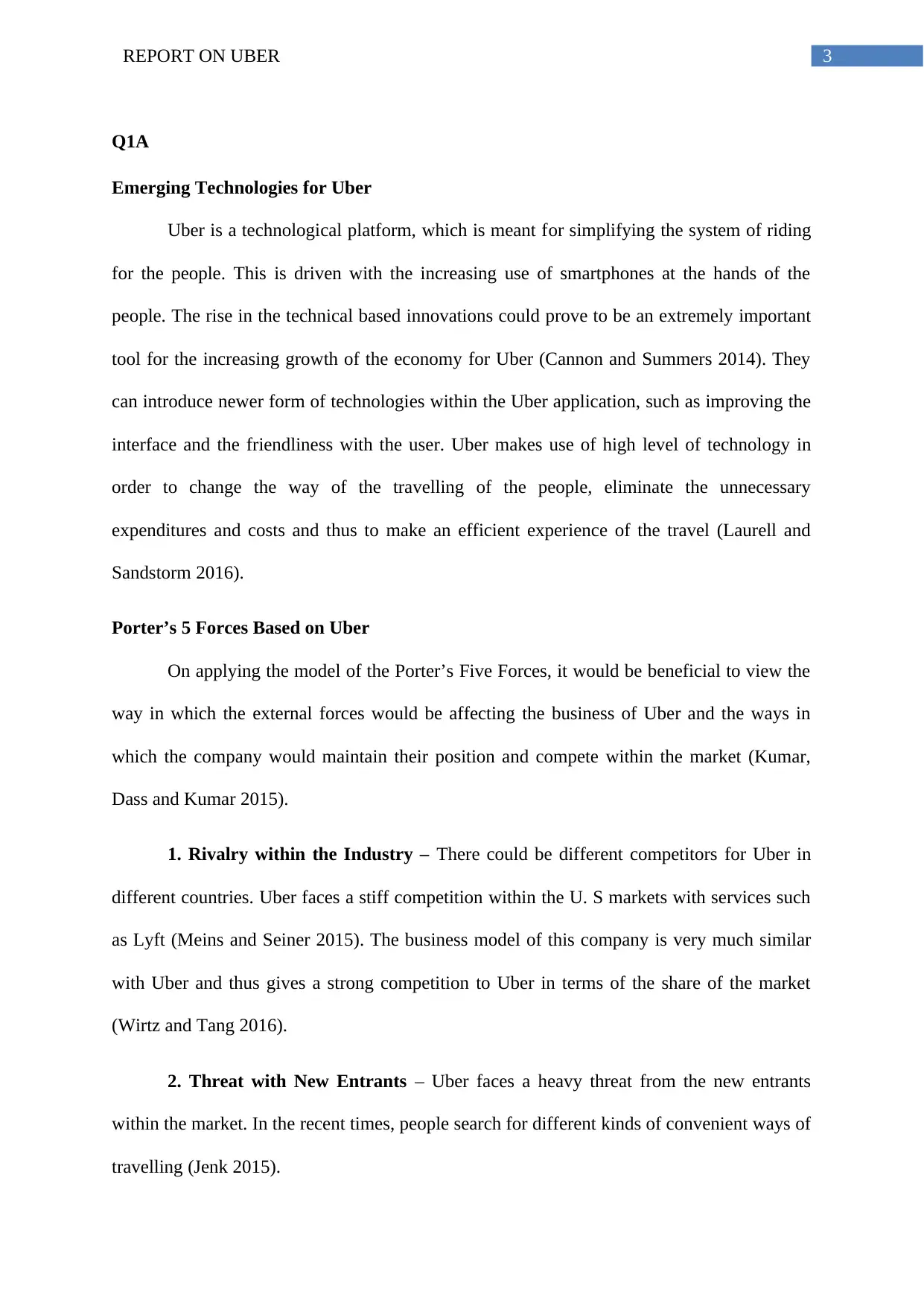
3REPORT ON UBER
Q1A
Emerging Technologies for Uber
Uber is a technological platform, which is meant for simplifying the system of riding
for the people. This is driven with the increasing use of smartphones at the hands of the
people. The rise in the technical based innovations could prove to be an extremely important
tool for the increasing growth of the economy for Uber (Cannon and Summers 2014). They
can introduce newer form of technologies within the Uber application, such as improving the
interface and the friendliness with the user. Uber makes use of high level of technology in
order to change the way of the travelling of the people, eliminate the unnecessary
expenditures and costs and thus to make an efficient experience of the travel (Laurell and
Sandstorm 2016).
Porter’s 5 Forces Based on Uber
On applying the model of the Porter’s Five Forces, it would be beneficial to view the
way in which the external forces would be affecting the business of Uber and the ways in
which the company would maintain their position and compete within the market (Kumar,
Dass and Kumar 2015).
1. Rivalry within the Industry – There could be different competitors for Uber in
different countries. Uber faces a stiff competition within the U. S markets with services such
as Lyft (Meins and Seiner 2015). The business model of this company is very much similar
with Uber and thus gives a strong competition to Uber in terms of the share of the market
(Wirtz and Tang 2016).
2. Threat with New Entrants – Uber faces a heavy threat from the new entrants
within the market. In the recent times, people search for different kinds of convenient ways of
travelling (Jenk 2015).
Q1A
Emerging Technologies for Uber
Uber is a technological platform, which is meant for simplifying the system of riding
for the people. This is driven with the increasing use of smartphones at the hands of the
people. The rise in the technical based innovations could prove to be an extremely important
tool for the increasing growth of the economy for Uber (Cannon and Summers 2014). They
can introduce newer form of technologies within the Uber application, such as improving the
interface and the friendliness with the user. Uber makes use of high level of technology in
order to change the way of the travelling of the people, eliminate the unnecessary
expenditures and costs and thus to make an efficient experience of the travel (Laurell and
Sandstorm 2016).
Porter’s 5 Forces Based on Uber
On applying the model of the Porter’s Five Forces, it would be beneficial to view the
way in which the external forces would be affecting the business of Uber and the ways in
which the company would maintain their position and compete within the market (Kumar,
Dass and Kumar 2015).
1. Rivalry within the Industry – There could be different competitors for Uber in
different countries. Uber faces a stiff competition within the U. S markets with services such
as Lyft (Meins and Seiner 2015). The business model of this company is very much similar
with Uber and thus gives a strong competition to Uber in terms of the share of the market
(Wirtz and Tang 2016).
2. Threat with New Entrants – Uber faces a heavy threat from the new entrants
within the market. In the recent times, people search for different kinds of convenient ways of
travelling (Jenk 2015).
Paraphrase This Document
Need a fresh take? Get an instant paraphrase of this document with our AI Paraphraser
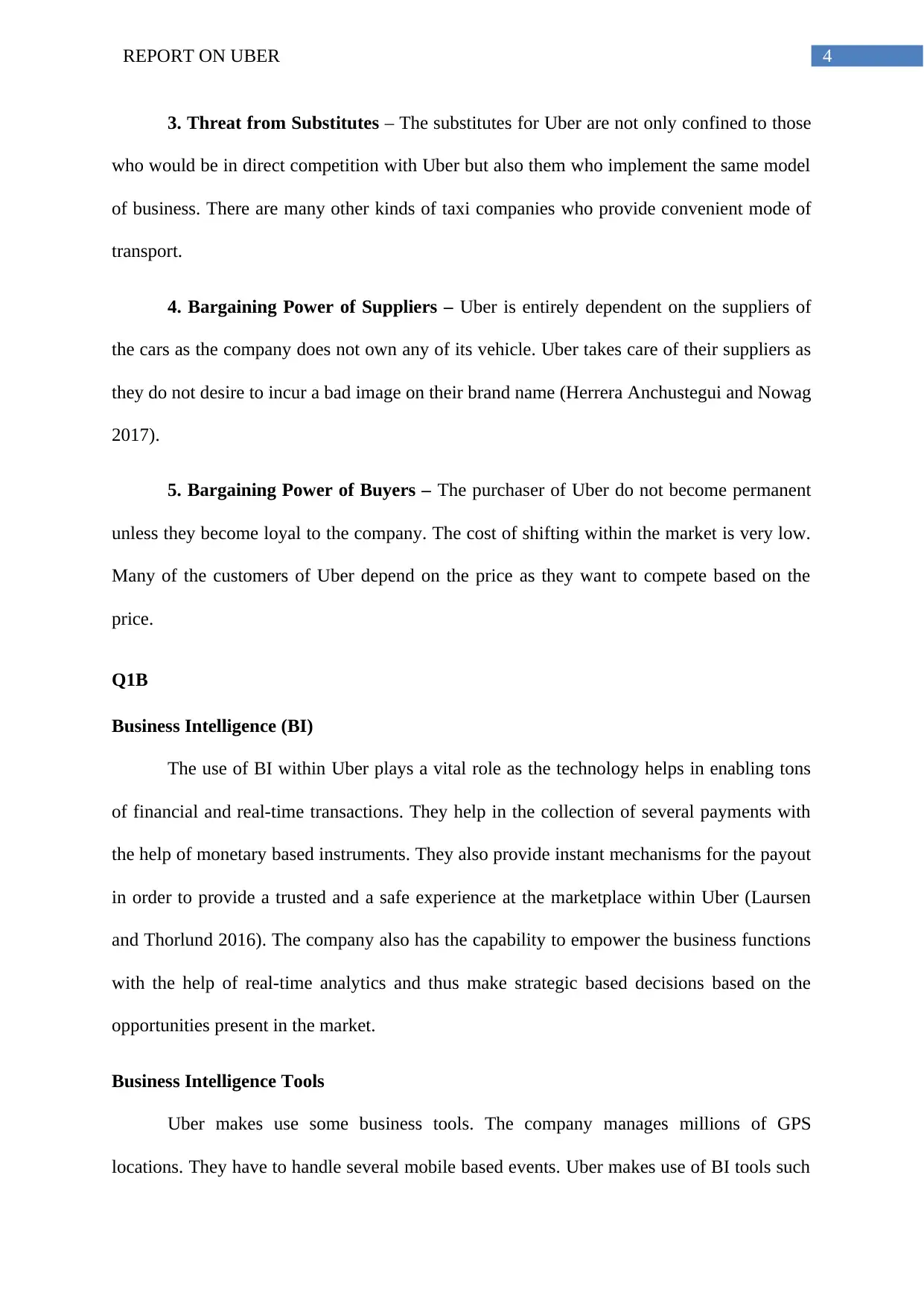
4REPORT ON UBER
3. Threat from Substitutes – The substitutes for Uber are not only confined to those
who would be in direct competition with Uber but also them who implement the same model
of business. There are many other kinds of taxi companies who provide convenient mode of
transport.
4. Bargaining Power of Suppliers – Uber is entirely dependent on the suppliers of
the cars as the company does not own any of its vehicle. Uber takes care of their suppliers as
they do not desire to incur a bad image on their brand name (Herrera Anchustegui and Nowag
2017).
5. Bargaining Power of Buyers – The purchaser of Uber do not become permanent
unless they become loyal to the company. The cost of shifting within the market is very low.
Many of the customers of Uber depend on the price as they want to compete based on the
price.
Q1B
Business Intelligence (BI)
The use of BI within Uber plays a vital role as the technology helps in enabling tons
of financial and real-time transactions. They help in the collection of several payments with
the help of monetary based instruments. They also provide instant mechanisms for the payout
in order to provide a trusted and a safe experience at the marketplace within Uber (Laursen
and Thorlund 2016). The company also has the capability to empower the business functions
with the help of real-time analytics and thus make strategic based decisions based on the
opportunities present in the market.
Business Intelligence Tools
Uber makes use some business tools. The company manages millions of GPS
locations. They have to handle several mobile based events. Uber makes use of BI tools such
3. Threat from Substitutes – The substitutes for Uber are not only confined to those
who would be in direct competition with Uber but also them who implement the same model
of business. There are many other kinds of taxi companies who provide convenient mode of
transport.
4. Bargaining Power of Suppliers – Uber is entirely dependent on the suppliers of
the cars as the company does not own any of its vehicle. Uber takes care of their suppliers as
they do not desire to incur a bad image on their brand name (Herrera Anchustegui and Nowag
2017).
5. Bargaining Power of Buyers – The purchaser of Uber do not become permanent
unless they become loyal to the company. The cost of shifting within the market is very low.
Many of the customers of Uber depend on the price as they want to compete based on the
price.
Q1B
Business Intelligence (BI)
The use of BI within Uber plays a vital role as the technology helps in enabling tons
of financial and real-time transactions. They help in the collection of several payments with
the help of monetary based instruments. They also provide instant mechanisms for the payout
in order to provide a trusted and a safe experience at the marketplace within Uber (Laursen
and Thorlund 2016). The company also has the capability to empower the business functions
with the help of real-time analytics and thus make strategic based decisions based on the
opportunities present in the market.
Business Intelligence Tools
Uber makes use some business tools. The company manages millions of GPS
locations. They have to handle several mobile based events. Uber makes use of BI tools such
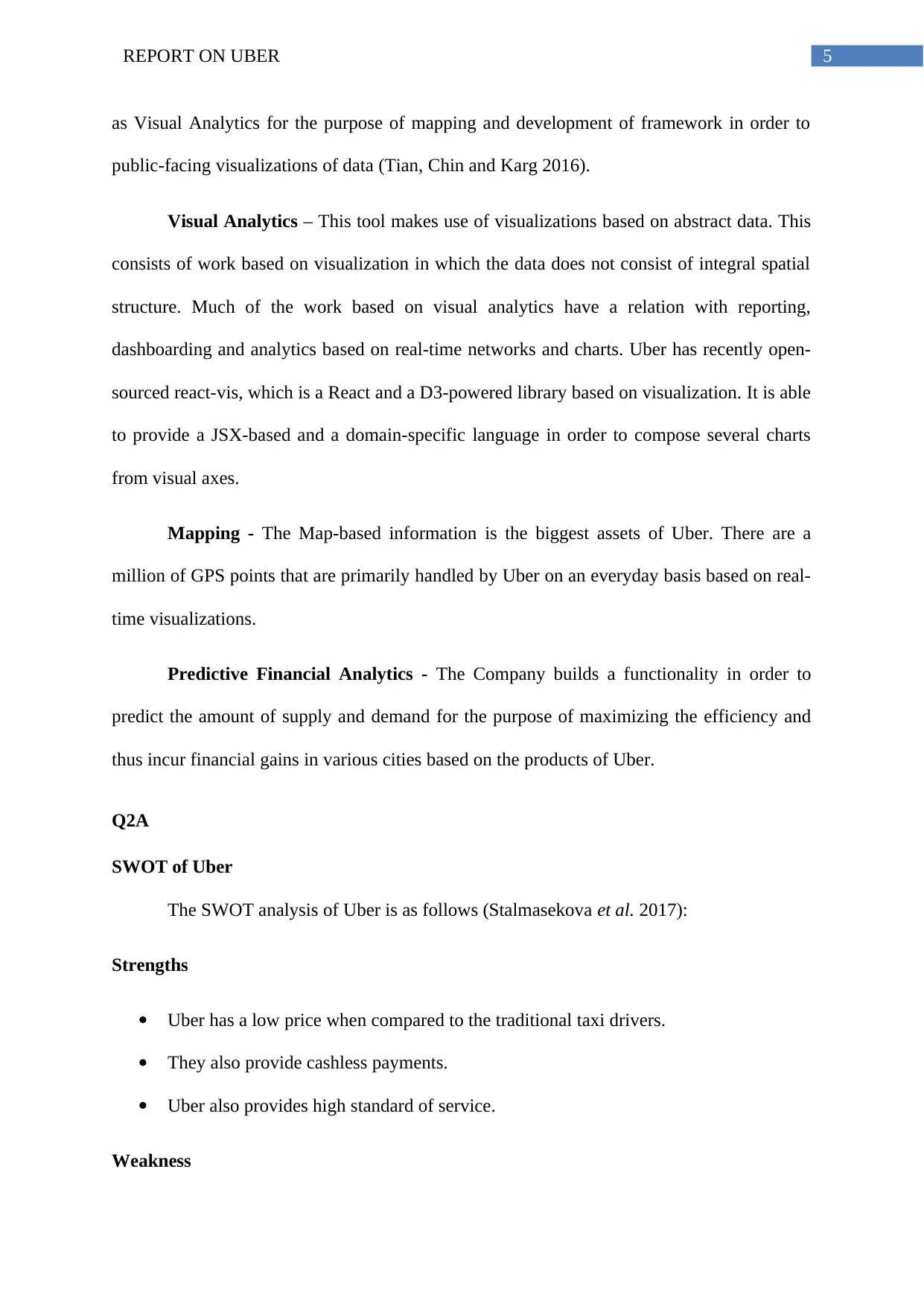
5REPORT ON UBER
as Visual Analytics for the purpose of mapping and development of framework in order to
public-facing visualizations of data (Tian, Chin and Karg 2016).
Visual Analytics – This tool makes use of visualizations based on abstract data. This
consists of work based on visualization in which the data does not consist of integral spatial
structure. Much of the work based on visual analytics have a relation with reporting,
dashboarding and analytics based on real-time networks and charts. Uber has recently open-
sourced react-vis, which is a React and a D3-powered library based on visualization. It is able
to provide a JSX-based and a domain-specific language in order to compose several charts
from visual axes.
Mapping - The Map-based information is the biggest assets of Uber. There are a
million of GPS points that are primarily handled by Uber on an everyday basis based on real-
time visualizations.
Predictive Financial Analytics - The Company builds a functionality in order to
predict the amount of supply and demand for the purpose of maximizing the efficiency and
thus incur financial gains in various cities based on the products of Uber.
Q2A
SWOT of Uber
The SWOT analysis of Uber is as follows (Stalmasekova et al. 2017):
Strengths
Uber has a low price when compared to the traditional taxi drivers.
They also provide cashless payments.
Uber also provides high standard of service.
Weakness
as Visual Analytics for the purpose of mapping and development of framework in order to
public-facing visualizations of data (Tian, Chin and Karg 2016).
Visual Analytics – This tool makes use of visualizations based on abstract data. This
consists of work based on visualization in which the data does not consist of integral spatial
structure. Much of the work based on visual analytics have a relation with reporting,
dashboarding and analytics based on real-time networks and charts. Uber has recently open-
sourced react-vis, which is a React and a D3-powered library based on visualization. It is able
to provide a JSX-based and a domain-specific language in order to compose several charts
from visual axes.
Mapping - The Map-based information is the biggest assets of Uber. There are a
million of GPS points that are primarily handled by Uber on an everyday basis based on real-
time visualizations.
Predictive Financial Analytics - The Company builds a functionality in order to
predict the amount of supply and demand for the purpose of maximizing the efficiency and
thus incur financial gains in various cities based on the products of Uber.
Q2A
SWOT of Uber
The SWOT analysis of Uber is as follows (Stalmasekova et al. 2017):
Strengths
Uber has a low price when compared to the traditional taxi drivers.
They also provide cashless payments.
Uber also provides high standard of service.
Weakness
⊘ This is a preview!⊘
Do you want full access?
Subscribe today to unlock all pages.

Trusted by 1+ million students worldwide
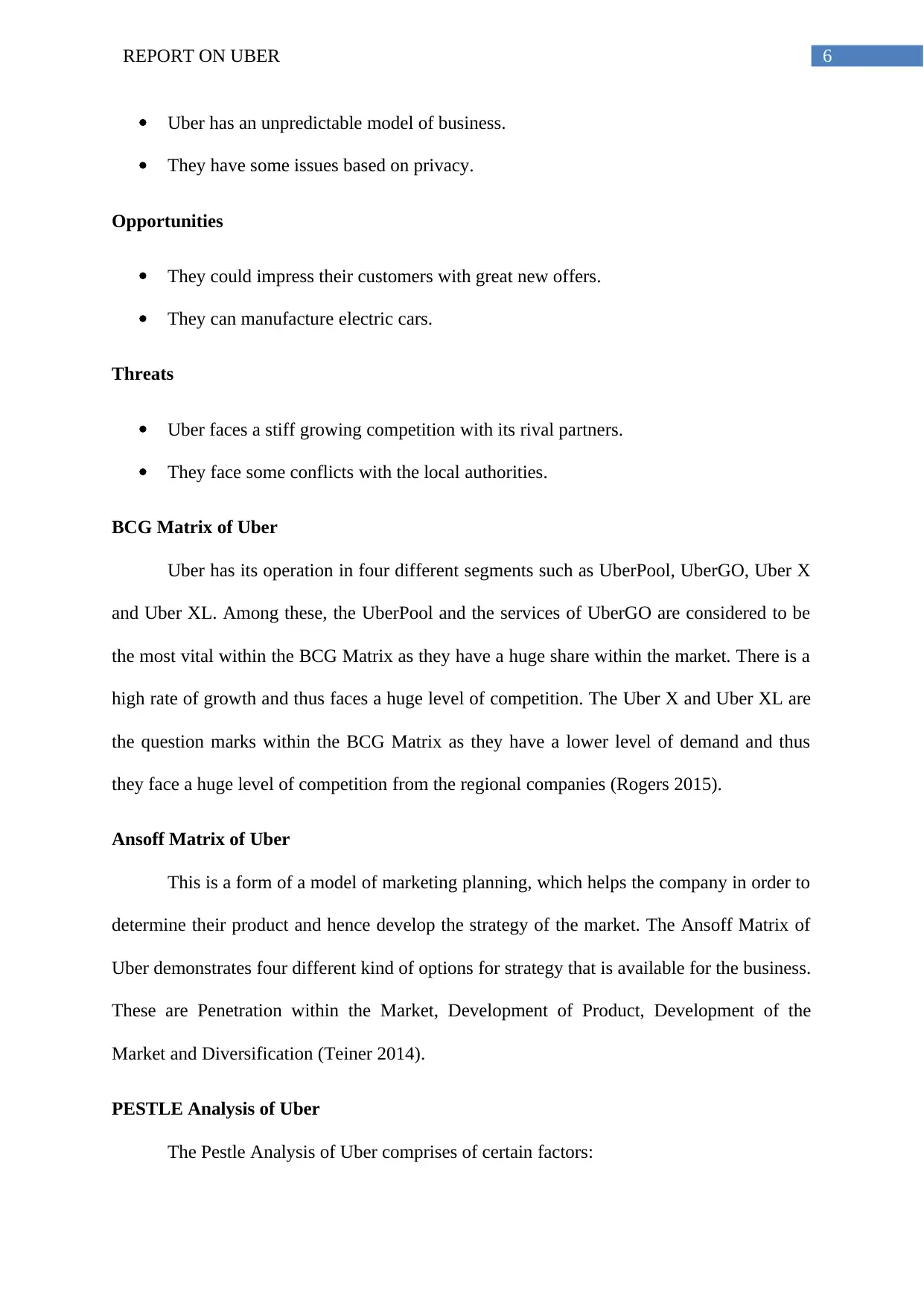
6REPORT ON UBER
Uber has an unpredictable model of business.
They have some issues based on privacy.
Opportunities
They could impress their customers with great new offers.
They can manufacture electric cars.
Threats
Uber faces a stiff growing competition with its rival partners.
They face some conflicts with the local authorities.
BCG Matrix of Uber
Uber has its operation in four different segments such as UberPool, UberGO, Uber X
and Uber XL. Among these, the UberPool and the services of UberGO are considered to be
the most vital within the BCG Matrix as they have a huge share within the market. There is a
high rate of growth and thus faces a huge level of competition. The Uber X and Uber XL are
the question marks within the BCG Matrix as they have a lower level of demand and thus
they face a huge level of competition from the regional companies (Rogers 2015).
Ansoff Matrix of Uber
This is a form of a model of marketing planning, which helps the company in order to
determine their product and hence develop the strategy of the market. The Ansoff Matrix of
Uber demonstrates four different kind of options for strategy that is available for the business.
These are Penetration within the Market, Development of Product, Development of the
Market and Diversification (Teiner 2014).
PESTLE Analysis of Uber
The Pestle Analysis of Uber comprises of certain factors:
Uber has an unpredictable model of business.
They have some issues based on privacy.
Opportunities
They could impress their customers with great new offers.
They can manufacture electric cars.
Threats
Uber faces a stiff growing competition with its rival partners.
They face some conflicts with the local authorities.
BCG Matrix of Uber
Uber has its operation in four different segments such as UberPool, UberGO, Uber X
and Uber XL. Among these, the UberPool and the services of UberGO are considered to be
the most vital within the BCG Matrix as they have a huge share within the market. There is a
high rate of growth and thus faces a huge level of competition. The Uber X and Uber XL are
the question marks within the BCG Matrix as they have a lower level of demand and thus
they face a huge level of competition from the regional companies (Rogers 2015).
Ansoff Matrix of Uber
This is a form of a model of marketing planning, which helps the company in order to
determine their product and hence develop the strategy of the market. The Ansoff Matrix of
Uber demonstrates four different kind of options for strategy that is available for the business.
These are Penetration within the Market, Development of Product, Development of the
Market and Diversification (Teiner 2014).
PESTLE Analysis of Uber
The Pestle Analysis of Uber comprises of certain factors:
Paraphrase This Document
Need a fresh take? Get an instant paraphrase of this document with our AI Paraphraser

7REPORT ON UBER
Political Factor
Uber has to follow the minimum rules of wage.
They have to deal with bans within many countries.
Economic Factor
The facilities are easily accessible.
The fares are affordable.
Although jobs are being offered, the pay might not be convincible.
Social Factor
Uber has a user-friendly interface.
They have quick pick-up facility.
They provide better form of ride experience than the traditional taxis.
Technological Factor
They have an excellent mobile based application for their users.
They make use of social media and other forms of electronic media for their
promotion.
Legal Factor
Uber needs to follow employee and labor related laws of safety.
The copyright laws needs to revised.
Environmental Factor
The usage of fuel might increase.
Political Factor
Uber has to follow the minimum rules of wage.
They have to deal with bans within many countries.
Economic Factor
The facilities are easily accessible.
The fares are affordable.
Although jobs are being offered, the pay might not be convincible.
Social Factor
Uber has a user-friendly interface.
They have quick pick-up facility.
They provide better form of ride experience than the traditional taxis.
Technological Factor
They have an excellent mobile based application for their users.
They make use of social media and other forms of electronic media for their
promotion.
Legal Factor
Uber needs to follow employee and labor related laws of safety.
The copyright laws needs to revised.
Environmental Factor
The usage of fuel might increase.
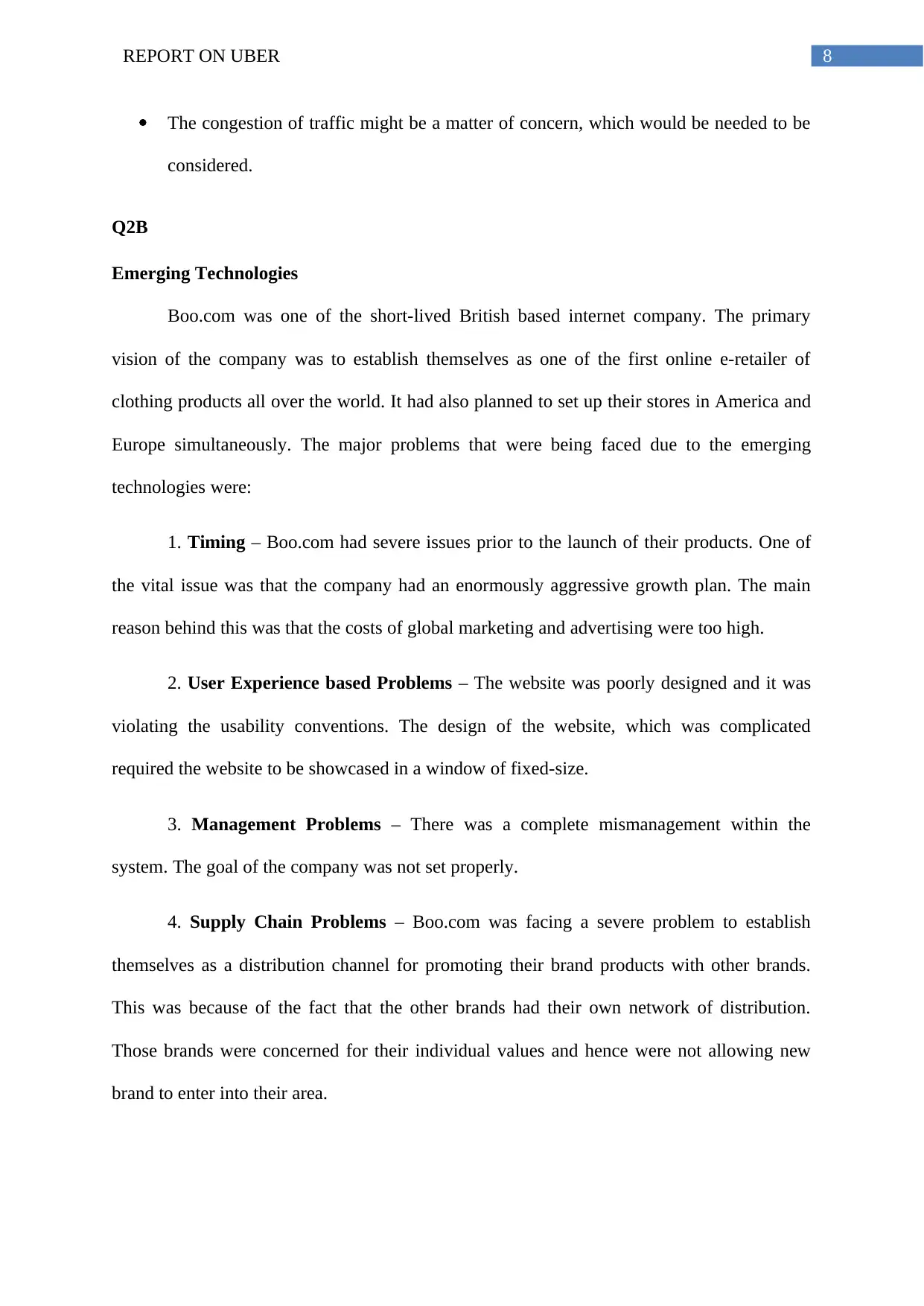
8REPORT ON UBER
The congestion of traffic might be a matter of concern, which would be needed to be
considered.
Q2B
Emerging Technologies
Boo.com was one of the short-lived British based internet company. The primary
vision of the company was to establish themselves as one of the first online e-retailer of
clothing products all over the world. It had also planned to set up their stores in America and
Europe simultaneously. The major problems that were being faced due to the emerging
technologies were:
1. Timing – Boo.com had severe issues prior to the launch of their products. One of
the vital issue was that the company had an enormously aggressive growth plan. The main
reason behind this was that the costs of global marketing and advertising were too high.
2. User Experience based Problems – The website was poorly designed and it was
violating the usability conventions. The design of the website, which was complicated
required the website to be showcased in a window of fixed-size.
3. Management Problems – There was a complete mismanagement within the
system. The goal of the company was not set properly.
4. Supply Chain Problems – Boo.com was facing a severe problem to establish
themselves as a distribution channel for promoting their brand products with other brands.
This was because of the fact that the other brands had their own network of distribution.
Those brands were concerned for their individual values and hence were not allowing new
brand to enter into their area.
The congestion of traffic might be a matter of concern, which would be needed to be
considered.
Q2B
Emerging Technologies
Boo.com was one of the short-lived British based internet company. The primary
vision of the company was to establish themselves as one of the first online e-retailer of
clothing products all over the world. It had also planned to set up their stores in America and
Europe simultaneously. The major problems that were being faced due to the emerging
technologies were:
1. Timing – Boo.com had severe issues prior to the launch of their products. One of
the vital issue was that the company had an enormously aggressive growth plan. The main
reason behind this was that the costs of global marketing and advertising were too high.
2. User Experience based Problems – The website was poorly designed and it was
violating the usability conventions. The design of the website, which was complicated
required the website to be showcased in a window of fixed-size.
3. Management Problems – There was a complete mismanagement within the
system. The goal of the company was not set properly.
4. Supply Chain Problems – Boo.com was facing a severe problem to establish
themselves as a distribution channel for promoting their brand products with other brands.
This was because of the fact that the other brands had their own network of distribution.
Those brands were concerned for their individual values and hence were not allowing new
brand to enter into their area.
⊘ This is a preview!⊘
Do you want full access?
Subscribe today to unlock all pages.

Trusted by 1+ million students worldwide

9REPORT ON UBER
Hence, it could be seen that Boo.com could not benefit itself as a leading brand with
the help of emerging technologies. In order to emerge as the leading online retailer, it would
be highly recommended for any retailer to learn from the previous mistakes and thus make
the full use of emerging technologies. The retailers should create a very good user experience
so that the consumer would choose the brand as the best option.
Q2C
The failure of Boo.com should be a lesson for the future growth of other kinds of
online retailers in order to make a stand within the market and thus become successful
retailers. There are a lot of emerging technologies and thus the online brands should make the
full use of such technologies.
Base on the following case study, it could be said that Uber should decide the future
course of actions based on the proper analysis of data derived from emerging technologies
(Cramer and Krueger 2016).
Pestle Analysis
Political and Legal
The government of different countries should require commercial based licenses.
The profit margin should be decreased due to the higher costs.
Economic
The price sensitivity should be decreased.
The increasing rate of profit within the corporate sector is able to increase the demand
for the public transportation (Ng 2016).
Social
Hence, it could be seen that Boo.com could not benefit itself as a leading brand with
the help of emerging technologies. In order to emerge as the leading online retailer, it would
be highly recommended for any retailer to learn from the previous mistakes and thus make
the full use of emerging technologies. The retailers should create a very good user experience
so that the consumer would choose the brand as the best option.
Q2C
The failure of Boo.com should be a lesson for the future growth of other kinds of
online retailers in order to make a stand within the market and thus become successful
retailers. There are a lot of emerging technologies and thus the online brands should make the
full use of such technologies.
Base on the following case study, it could be said that Uber should decide the future
course of actions based on the proper analysis of data derived from emerging technologies
(Cramer and Krueger 2016).
Pestle Analysis
Political and Legal
The government of different countries should require commercial based licenses.
The profit margin should be decreased due to the higher costs.
Economic
The price sensitivity should be decreased.
The increasing rate of profit within the corporate sector is able to increase the demand
for the public transportation (Ng 2016).
Social
Paraphrase This Document
Need a fresh take? Get an instant paraphrase of this document with our AI Paraphraser
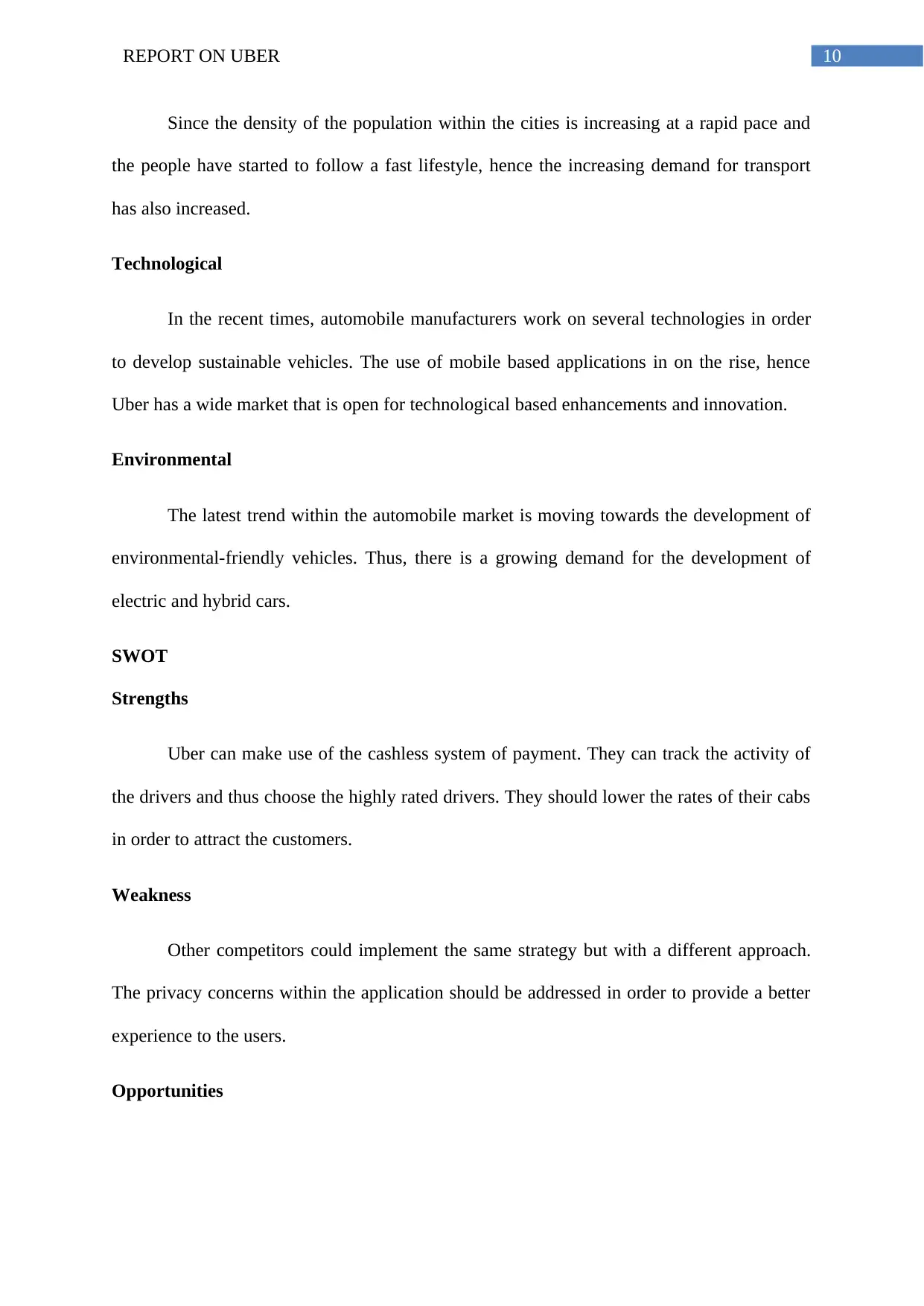
10REPORT ON UBER
Since the density of the population within the cities is increasing at a rapid pace and
the people have started to follow a fast lifestyle, hence the increasing demand for transport
has also increased.
Technological
In the recent times, automobile manufacturers work on several technologies in order
to develop sustainable vehicles. The use of mobile based applications in on the rise, hence
Uber has a wide market that is open for technological based enhancements and innovation.
Environmental
The latest trend within the automobile market is moving towards the development of
environmental-friendly vehicles. Thus, there is a growing demand for the development of
electric and hybrid cars.
SWOT
Strengths
Uber can make use of the cashless system of payment. They can track the activity of
the drivers and thus choose the highly rated drivers. They should lower the rates of their cabs
in order to attract the customers.
Weakness
Other competitors could implement the same strategy but with a different approach.
The privacy concerns within the application should be addressed in order to provide a better
experience to the users.
Opportunities
Since the density of the population within the cities is increasing at a rapid pace and
the people have started to follow a fast lifestyle, hence the increasing demand for transport
has also increased.
Technological
In the recent times, automobile manufacturers work on several technologies in order
to develop sustainable vehicles. The use of mobile based applications in on the rise, hence
Uber has a wide market that is open for technological based enhancements and innovation.
Environmental
The latest trend within the automobile market is moving towards the development of
environmental-friendly vehicles. Thus, there is a growing demand for the development of
electric and hybrid cars.
SWOT
Strengths
Uber can make use of the cashless system of payment. They can track the activity of
the drivers and thus choose the highly rated drivers. They should lower the rates of their cabs
in order to attract the customers.
Weakness
Other competitors could implement the same strategy but with a different approach.
The privacy concerns within the application should be addressed in order to provide a better
experience to the users.
Opportunities

11REPORT ON UBER
Uber can provide services within the suburban areas where the taxi services are still
not available. The big and new markets within some countries could be exploited, where the
taxi services are expensive and inconvenient. They should also provide services to elder
people.
Threats
There are some legal operations within some countries, which could ban Uber from
operating there. The threats from fraud drivers and new markets are also on the rise, which
pose a serious threat for the brand image of the company.
BCG Matrix
The topmost services of Uber such as UberPool and UberGO, which are the most
favorable options for customers should have lower service cost so that the customers would
prefer those services. The other services, which are provided by Uber and are mostly ignored
by customers due to their high rates such as Uber X and Uber XL should be provided
attention.
Q3
Critical Analysis
Specialist Software Used by Uber – The software used by Uber is constantly
evolving. The brand has a high and complex globally distributed system (Chen, Mislove and
Wilson 2015). Hence, it needs to be consistent and reliable in its performance. In the early
times, the software within Uber was mainly written in PHP. In the recent times, Uber makes
use of two technologies such as Node and Python (Al-Rfou et al. 2016). The different
sections within Uber makes use of some of the software tools such as:
IT and Development: Twilio, Cisco Jasper, Redis, Atlassian JIRA
Analytics: Heap, Mixpanel
Uber can provide services within the suburban areas where the taxi services are still
not available. The big and new markets within some countries could be exploited, where the
taxi services are expensive and inconvenient. They should also provide services to elder
people.
Threats
There are some legal operations within some countries, which could ban Uber from
operating there. The threats from fraud drivers and new markets are also on the rise, which
pose a serious threat for the brand image of the company.
BCG Matrix
The topmost services of Uber such as UberPool and UberGO, which are the most
favorable options for customers should have lower service cost so that the customers would
prefer those services. The other services, which are provided by Uber and are mostly ignored
by customers due to their high rates such as Uber X and Uber XL should be provided
attention.
Q3
Critical Analysis
Specialist Software Used by Uber – The software used by Uber is constantly
evolving. The brand has a high and complex globally distributed system (Chen, Mislove and
Wilson 2015). Hence, it needs to be consistent and reliable in its performance. In the early
times, the software within Uber was mainly written in PHP. In the recent times, Uber makes
use of two technologies such as Node and Python (Al-Rfou et al. 2016). The different
sections within Uber makes use of some of the software tools such as:
IT and Development: Twilio, Cisco Jasper, Redis, Atlassian JIRA
Analytics: Heap, Mixpanel
⊘ This is a preview!⊘
Do you want full access?
Subscribe today to unlock all pages.

Trusted by 1+ million students worldwide
1 out of 18
Related Documents
Your All-in-One AI-Powered Toolkit for Academic Success.
+13062052269
info@desklib.com
Available 24*7 on WhatsApp / Email
![[object Object]](/_next/static/media/star-bottom.7253800d.svg)
Unlock your academic potential
Copyright © 2020–2025 A2Z Services. All Rights Reserved. Developed and managed by ZUCOL.





